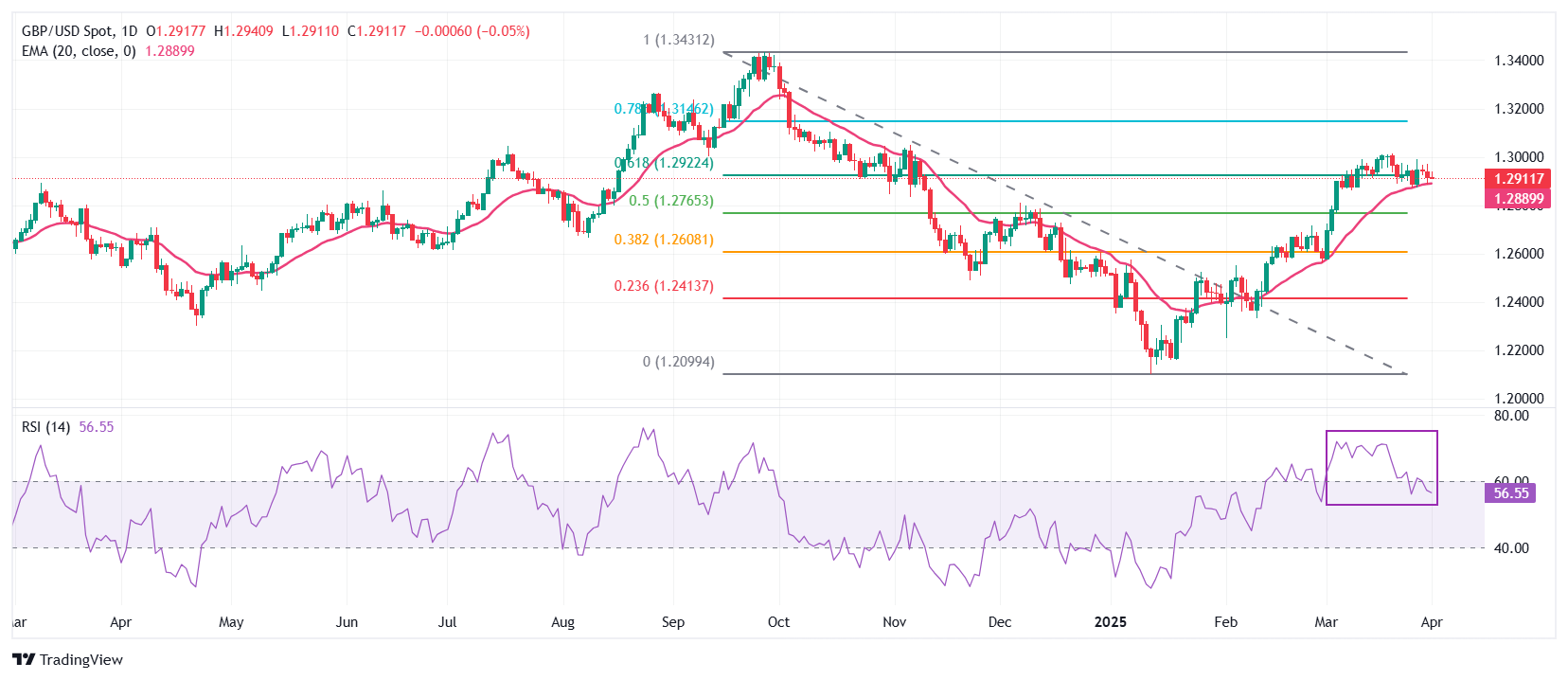Pound Sterling Flattens Against US Dollar As Investors Await New Suite Of Trump’s Tariffs
- The Pound Sterling trades sideways against the US Dollar around 1.2900 as investors await the release of US President Trump’s reciprocal tariffs.
- Retaliatory tariffs from US trading allies could result in a global trade war.
- The UK fiscal watchdog projects a 1% cut in the size of the economy due to potential risks of Trump’s tariffs.
The Pound Sterling (GBP) ranges around 1.2900 against the US Dollar (USD) in Tuesday’s European session. The GBP/USD pair flattens as investors brace for reciprocal tariffs from United States (US) President Donald Trump, which will be announced on the so-called “Liberation Day” on Wednesday.
President Trump is expected to impose large tariffs on nations with significantly higher trade surpluses against the US, aiming to fix what he calls “trade imbalances”.
On Monday, US Treasury Secretary Scott Bessent said in an interview with Fox News that people are going to see “fair trade” that will make the global trading system “fair for American workers” again, and that the US trading allies will have an opportunity to lower their “tariffs and non-tariff barriers”.
Given that higher tariffs from Donald Trump are inevitable, investors will majorly focus on responses from US trading partners. Trump's tariffs are expected to majorly impact China, the Eurozone, Canada, Japan, and Mexico, and any retaliatory measures from them will lead to an all-over global trade war. Such a scenario will be unfavorable for global economic growth, including the US, as US importers will bear the impact of higher tariffs.
This week, investors will also focus on a slew of US business and labor market data, which will influence market expectations for the Federal Reserve’s (Fed) monetary policy outlook. Meanwhile, Fed officials have been guiding that interest rates should remain in their current range of 4.25%-4.50% as Trump’s economic policies are expected to be inflationary for the economy.
In Tuesday’s session, investors will focus on the US S&P Global and ISM Manufacturing Purchasing Managers Index (PMI) data for March, which will be published at 13:45 and 14:00 GMT, respectively. The revised S&P Global Manufacturing PMI is expected to remain unchanged from the preliminary reading of 49.8 in March, while the ISM Manufacturing PMI is estimated to have fallen to 49.5 from 50.3 in February. A figure below 50.0 suggests that the manufacturing sector activity contracted.
Daily digest market movers: Pound Sterling trades with caution as US-UK economic deal delays
- The Pound Sterling trades cautiously against its major peers on Tuesday, with United Kingdom (UK) officials assessing potential economic risks from Trump’s tariffs, which will be unveiled on Wednesday.
- On Monday, UK Prime Minister Keir Starmer’s spokesman said that the administration has been actively preparing for all “eventualities” ahead of President Trump's announcement of “planned tariffs”, which are expected to impact the “UK alongside other countries”. Starmer added that negotiations between London and Washington on securing an economic deal that would have averted tariffs have been extended beyond Wednesday.
- The UK Office for Business Responsibility (OBR) warns that Trump’s policies could wipe out the government fiscal buffer and cut the economy’s size by as much as 1%. Such a scenario could force the Bank of England (BoE) to adopt a swift monetary easing stance to stimulate economic growth. Currently, traders see the BoE reducing interest rates two times this year. The BoE has already cut interest rates once in 2025.
- On the economic front, investors will focus on revised S&P Global/CIPS Manufacturing PMI data for March, which will be published at 08:30 GMT. The Manufacturing PMI is expected to have remained in line with preliminary estimates of 44.6.
Technical Analysis: Pound Sterling ranges against US Dollar around 1.2900
(Click on image to enlarge)
The Pound Sterling trades inside Monday’s trading range against the US Dollar on Tuesday. The GBP/USD pair continues to wobble around the 61.8% Fibonacci retracement, plotted from late-September high to mid-January low, near 1.2930. The 20-day Exponential Moving Average (EMA) continues to provide support to the pair around 1.2890.
The 14-day Relative Strength Index (RSI) cools down to near 60.00 after turning overbought above 70.00. Should a fresh bullish momentum come into action if the RSI resumes the upside journey after holding above the 60.00 level
Looking down, the 50% Fibonacci retracement at 1.2770 and the 38.2% Fibonacci retracement at 1.2615 will act as key support zones for the pair. On the upside, the October 15 high of 1.3100 will act as a key resistance zone.
More By This Author:
EUR/USD Flattens Ahead Of Trump’s Planned Reciprocal Tariff AnnouncementEUR/USD Weakens Ahead Of US PCE Inflation, Trump’s Tariff Announcement
Pound Sterling Gains As UK Retail Sales Surprisingly Grew In February
Information on these pages contains forward-looking statements that involve risks and uncertainties. Markets and instruments profiled on this page are for informational purposes only and should not ...
more











